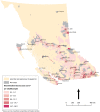Interpreting the results of a modified gravity model: examining access to primary health care physicians in five Canadian provinces and territories
- PMID: 22852816
- PMCID: PMC3522026
- DOI: 10.1186/1472-6963-12-230
Interpreting the results of a modified gravity model: examining access to primary health care physicians in five Canadian provinces and territories
Abstract
Background: Primary health care (PHC) encompasses an array of health and social services that focus on preventative, diagnostic, and basic care measures to maintain wellbeing and address illnesses. In Canada, PHC involves the provision of first-contact health care services by providers such as family physicians and general practitioners - collectively referred as PHC physicians here. Ensuring access is a key requirement of effective PHC delivery. This is because having access to PHC has been shown to positively impact a number of health outcomes.
Methods: We build on recent innovations in measuring potential spatial access to PHC physicians using geographic information systems (GIS) by running and then interpreting the findings of a modified gravity model. Elsewhere we have introduced the protocol for this model. In this article we run it for five selected Canadian provinces and territories. Our objectives are to present the results of the modified gravity model in order to: (1) understand how potential spatial access to PHC physicians can be interpreted in these Canadian jurisdictions, and (2) provide guidance regarding how findings of the modified gravity model should be interpreted in other analyses.
Results: Regarding the first objective, two distinct spatial patterns emerge regarding potential spatial access to PHC physicians in the five selected Canadian provinces: (1) a clear north-south pattern, where southern areas have greater potential spatial access than northern areas; and (2) while gradients of potential spatial access exist in and around urban areas, access outside of densely-to-moderately populated areas is fairly binary. Regarding the second objective, we identify three principles that others can use to interpret the findings of the modified gravity model when used in other research contexts.
Conclusions: Future applications of the modified gravity model are needed in order to refine the recommendations we provide on interpreting its results. It is important that studies are undertaken that can help administrators, policy-makers, researchers, and others with characterizing the state of access to PHC, including potential spatial access. We encourage further research to be done using GIS in order to offer new, spatial perspectives on issues of access to health services given the increased recognition that the place-based nature of health services can benefit from the use of the capabilities of GIS to enhance the role that visualization plays in decision-making.
Figures






Similar articles
-
Spatial Accessibility to Health Care Services: Identifying under-Serviced Neighbourhoods in Canadian Urban Areas.PLoS One. 2016 Dec 20;11(12):e0168208. doi: 10.1371/journal.pone.0168208. eCollection 2016. PLoS One. 2016. PMID: 27997577 Free PMC article.
-
Development of a primary care pandemic plan informed by in-depth policy analysis and interviews with family physicians across Canada during COVID-19: a qualitative case study protocol.BMJ Open. 2021 Jul 22;11(7):e048209. doi: 10.1136/bmjopen-2020-048209. BMJ Open. 2021. PMID: 34301660 Free PMC article.
-
Spatial access disparities to primary health care in rural and remote Australia.Geospat Health. 2015 Nov 4;10(2):358. doi: 10.4081/gh.2015.358. Geospat Health. 2015. PMID: 26618314
-
Measurement and rural primary health care: a scoping review.Rural Remote Health. 2019 Aug;19(3):4911. doi: 10.22605/RRH4911. Epub 2019 Aug 1. Rural Remote Health. 2019. PMID: 31365828
-
Government policies targeting primary care physician practice from 1998-2018 in three Canadian provinces: A jurisdictional scan.Health Policy. 2022 Jun;126(6):565-575. doi: 10.1016/j.healthpol.2022.03.006. Epub 2022 Mar 17. Health Policy. 2022. PMID: 35341630 Review.
Cited by
-
Understanding the Utilization of Tertiary Hospitals by Mild Disease Patients: Travel Cost Method Analysis.Risk Manag Healthc Policy. 2025 May 26;18:1747-1760. doi: 10.2147/RMHP.S506111. eCollection 2025. Risk Manag Healthc Policy. 2025. PMID: 40454348 Free PMC article.
-
Measurement of the potential geographic accessibility from call to definitive care for patient with acute stroke.Int J Health Geogr. 2018 Jan 12;17(1):1. doi: 10.1186/s12942-018-0121-4. Int J Health Geogr. 2018. PMID: 29329535 Free PMC article.
-
Explaining Accessibility and Satisfaction Related to Healthcare: A Mixed-Methods Approach.Soc Indic Res. 2017;133(2):719-739. doi: 10.1007/s11205-016-1371-9. Epub 2016 Jun 2. Soc Indic Res. 2017. PMID: 28890596 Free PMC article.
-
The approaches to measuring the potential spatial access to urban health services revisited: distance types and aggregation-error issues.Int J Health Geogr. 2017 Aug 23;16(1):32. doi: 10.1186/s12942-017-0105-9. Int J Health Geogr. 2017. PMID: 28830461 Free PMC article.
-
Effect and significance of incorporating access in estimating the number of required physicians: focus on differences in population density in the target area.Int J Health Geogr. 2021 May 17;20(1):21. doi: 10.1186/s12942-021-00274-0. Int J Health Geogr. 2021. PMID: 34001102 Free PMC article.
References
-
- Health Canada. What is primary health care? http://www.hc-sc.gc.ca/hcs-sss/prim/about-apropos_e.html.
-
- Broemeling A-M, Watson DE, Black C, Reid RJ. Measuring the Performance of Primary Health Care – Existing capacity and future information needs. Vancouver, BC: Centre for Health Services and Policy Research; 2006.
-
- Canadian Health Services Research Foundation. Sustaining Primary Health Care Renewal: A Report on the 2006 CHSRF Primary Healthcare Research Network Symposium. Ottawa, ON: Canadian Health Services Research Foundation; 2006.
-
- Hutchison B. A long time coming: primary health care renewal in Canada. Healthc Pap. 2008;8:10–24. - PubMed
Publication types
MeSH terms
Grants and funding
LinkOut - more resources
Full Text Sources

